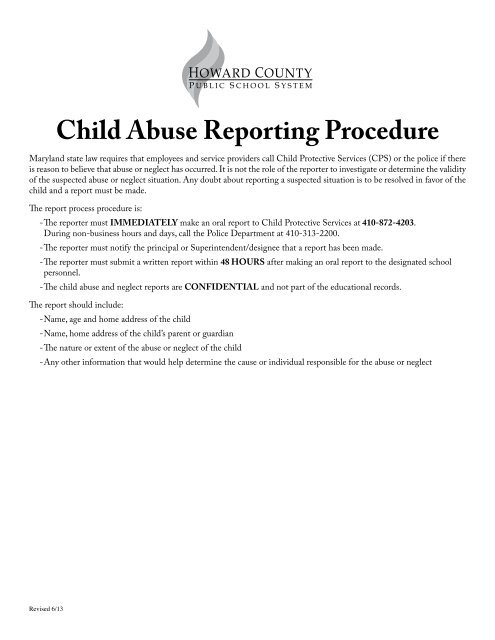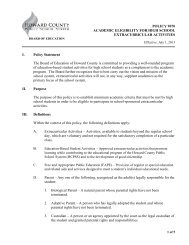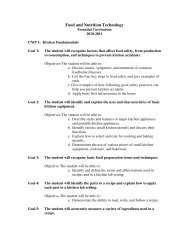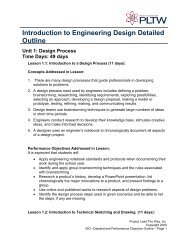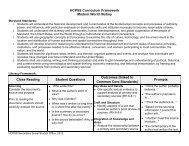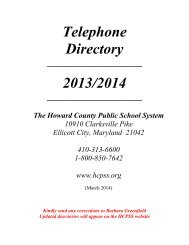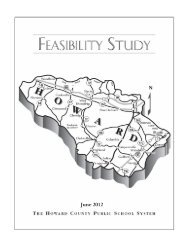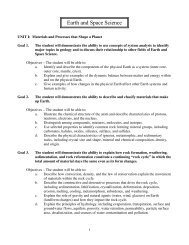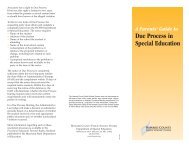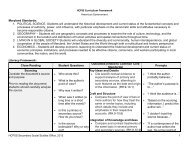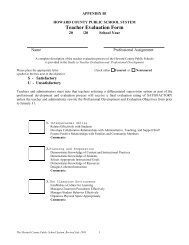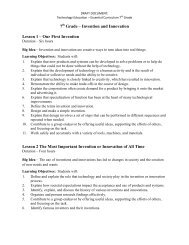Child Abuse Reporting Procedure
Child Abuse Reporting Procedure
Child Abuse Reporting Procedure
You also want an ePaper? Increase the reach of your titles
YUMPU automatically turns print PDFs into web optimized ePapers that Google loves.
<strong>Child</strong> <strong>Abuse</strong> <strong>Reporting</strong> <strong>Procedure</strong>Maryland state law requires that employees and service providers call <strong>Child</strong> Protective Services (CPS) or the police if thereis reason to believe that abuse or neglect has occurred. It is not the role of the reporter to investigate or determine the validityof the suspected abuse or neglect situation. Any doubt about reporting a suspected situation is to be resolved in favor of thechild and a report must be made.The report process procedure is:- The reporter must IMMEDIATELY make an oral report to <strong>Child</strong> Protective Services at 410-872-4203.During non-business hours and days, call the Police Department at 410-313-2200.- The reporter must notify the principal or Superintendent/designee that a report has been made.- The reporter must submit a written report within 48 HOURS after making an oral report to the designated schoolpersonnel.- The child abuse and neglect reports are CONFIDENTIAL and not part of the educational records.The report should include:- Name, age and home address of the child- Name, home address of the child’s parent or guardian- The nature or extent of the abuse or neglect of the child- Any other information that would help determine the cause or individual responsible for the abuse or neglectRevised 6/13
<strong>Child</strong> <strong>Abuse</strong> and NeglectKnow Your ResponsibilityIn Maryland, the child abuse and neglect law requires that anyone who SUSPECTS a child has been or is being mistreated mustreport the matter to <strong>Child</strong> Protective Services. Any person who knowingly fails to make a required report may be subjected to certainsanctions. Any person who, in good faith, makes a report of abuse or neglect is IMMUNE from any civil liability or criminal penalty.Physical <strong>Abuse</strong>The intended, non-accidental physical injury or cruelty to a childPhysical Indicators- Bruises in unusual patterns- Specific internal or skeletal injuries- Specific head, neck or back injuries- Rope, scalding or cigarette burnsNeglectThe chronic or repeated failure to provide life’s basic necessities to children such as food, clothing, shelter, medical care, attention tophysical hygiene, adequate supervision, social and educational opportunitiesPhysical Indicators- Inadequate shelter- Poor nutrition- Lack of medical care- Lack of emotional support- Improper clothing- Poor hygiene- Inadequate supervision and/orguidanceSexual <strong>Abuse</strong>Forced sexual contact (physical, non-physical and/or violent) by an older child or adultPhysical Indicators- Sexually transmitted disease- Repeated urinary tract infection in girls- Torn or bloody underclothes- Itching or pain in the genital oranal areaBehavioral Indicators- Overly compliant behavior- Easily frightened- Hurting other children- Accident prone- Fearful of physical contact- Anxious when home environment is discussed- Wearing inappropriate clothing to hide injuryEmotional <strong>Abuse</strong>/Mental InjuryThe chronic act or omission of an act that interferes with a child’s psychological, social growth and developmentPhysical Indicators- Criticizing- Shaming- Threatening- Public name-calling- Absence of emotional support- Openly admitting dislikeBehavioral Indicators- Hunger- Tiredness- Tardiness- Stealing- Apathetic appearance- Using alcohol or drugsBehavioral Indicators- New fear of a person or place- Nightmares and changes in sleeping patterns- Regressed behaviors e.g., bed wetting- Sexual language and/or behavior that isage inappropriateBehavioral Indicators- Truancy- Unusual fears- Poor peer relationships- Withdrawn or hyperactive- Inability to react with emotion- Immature or overly mature behavior- Constantly seeking affection or attention- Consistent expression of anger toward othersEnvironmental Indicators- Family/social isolation- Parental mental health issues- Family crises of unemployment,death, desertion or illness- Family alcohol abuse, drug use orinvolvement with the lawEnvironmental Indicators- Poverty- Unemployment- Parental illness- Lack of parental skills- Lack of interest in activitiesEnvironmental Indicators- Absence of one parent- Social isolation of family- Substance abuse/alcoholism- New adult or teen living at homeEnvironmental Indicators- Family isolation- Alcohol or drug abuse- Constant friction or violence at home- Parent’s inability/unwillingnessto provide affection/stimulationVulnerable Adults are persons 18 years of age or older who are believed to lack the physical or mental capacity to care for theirdaily needs. If you suspect abuse or neglect then call Adult Protective Services at 410-872-8823.Revised 6/13


